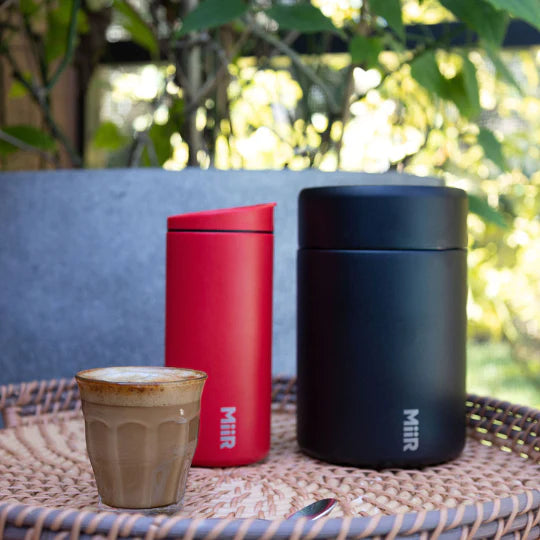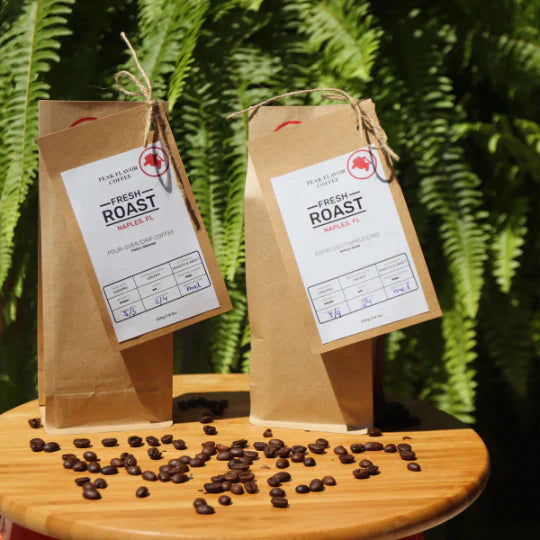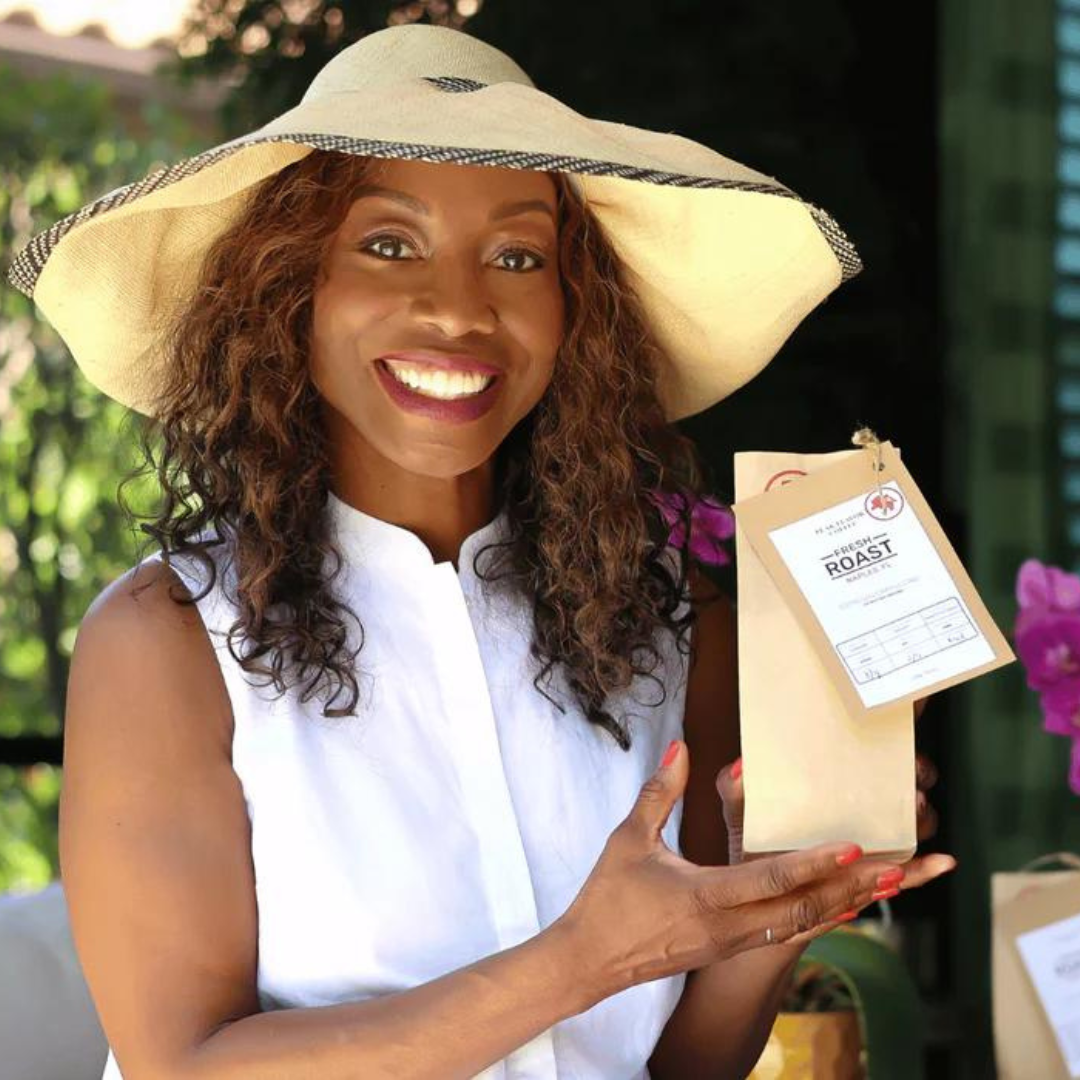No need for expensive specialty coffee beans or premium gourmet coffee blends. If you want to have better instead of bitter coffee, Italian coffee roasting experts recommend doing these four things:
- Make sure your whole beans are naturally dried, not washed.
- Use a coffee blend with high-altitude beans from larger coffee producing countries.
- Use fresh roasted coffee. A fresh coffee roast is roasted within the past 8 days.
- Check if your coffee is roasted following an Italian roast profile.
- Serve in a glass, so you can see the thick crema or abundant blooming, two good signs of best home coffee quality.
What is Peak Flavor Coffee?
We discovered that coffee in Italy always tastes better because Italian coffee is freshly roasted. Freshly roasted coffee reaches best or "Peak Flavor” on days 8-14 after roasting. Compare this to coffee from the grocery store, which is often >120 days old. Peak Flavor Coffee taste can only be achieved by a local roaster, who focuses on small batch coffee roasting. You will get best or Peak Flavor Coffee at home if your local roaster roasts your order on demand and delivers a fresh roast to you within days.
At Peak Flavor Coffee, we are committed to blend, roast fresh in small batches, and grind specifically for your home coffee maker. Only when you order. We make sure your order arrives at your doorstep on or before day 8 after we roast for you. This ensures that you can enjoy best tasting coffee or Peak Flavor Coffee from your home coffee maker. I invite you to try our coffee and taste the difference for yourself.
I want better, not bitter coffee. I want my coffee with natural sweetness instead of added sugar. I want my coffee with mildness instead of bitterness or acidity. I want my coffee to be creamy from the naturally occurring oils in coffee beans. I do not want creaminess from added milk-fat or artificial flavors. So, here are 6 tips from expert Italian coffee roasters to brew the best tasting coffee at home:
Here is what expert Italian coffee roasters do to get the best tasting coffee at home:
- Select a coffee brand that uses naturally dried beans instead of washed beans. Naturally dried beans have more natural sweetness.
- Select a blend of high-altitude beans. High-altitude beans grow slower to become more dense and therefore contain more natural sweetness.
- Use freshly roasted coffee beans only. A fresh roast is never roasted more than 8 days ago.
- Use coffee with an “Italian” roasting profile. Only expert Italian Coffee Roasting has an extended browning phase during which your coffee develops its natural sweetness and mildness.
- Grind only what you need to avoid oxidation and serve in a glass to see rich crema or blooming. Together with good smell, crema or blooming are the best visible signs of excellent coffee quality.
Introduction
I have tried many things to get best tasting coffee at home. But somehow, I still find that coffee in Italy always tastes better. Instead of using my home coffee maker, I often go out to expensive coffee shops to have a professional barista make my coffee for me. But I often end up with small amounts of coffee and lots of other ingredients in my brew.
My coffee shop coffee often needs sugar, lactose free milk, milk-fat, soy, artificial sweetener, or chemical flavors to mask the burnt or bitter notes of the local coffee shop’s roast.
When I decided to buy specialty beans or gourmet coffee at the grocery store, I noticed that supermarket coffee is never freshly roasted. In fact, I noticed that supermarket coffee is often more than 120 days old. And when I end up buying an expensive specialty coffee blend at the supermarket it often brews coffee that is bitter and acidic. Reading some of the specialty coffee labels makes me wonder if “fruity taste”, in reality rather means sour or acidic.
I wish there was a coffee that makes it easy to make best tasting coffee at home without being expensive. I wish there was a coffee in America that would make best tasting coffee at home easy, like indulgent Italian coffee. Why can Italians enjoy indulgent, good-value coffee at home whilst we have bitter, old supermarket coffee?
That’s why I went in search of how to blend and roast for naturally sweet coffee. Better Coffee. Not bitter coffee. Read on and discover 5 tips from expert Italian coffee roasters on how to blend and roast to indulge in best tasting home-coffee at good value. According to us, best tasting home-coffee should not cost more than $0.59 cents. So, what steps should you take to get the perfect coffee at home?
Tip 1: Select a coffee brand blending naturally dried beans instead of industrially washed beans. Naturally dried beans have more natural sweetness.
Natural coffee beans or dried beans are “natural” because the drying takes place in the coffee cherry before the coffee beans are de-pulped. Natural dry processing allows for natural fermentation in the cherry-fruit, which helps develop natural sweetness in the coffee bean. This natural drying process is mostly used by smaller coffee farmers at higher altitudes to ensure that their higher quality beans deliver superior taste.
During this natural drying process, fructose and sucrose develop to enable the naturally dried coffee bean to release significantly more sweetness and caramelization during the browning phase of expert Italian coffee roasting. In terms of delivering sweetness, naturally dried beans are superior in comparison to washed coffee beans. Naturally dried coffee beans can deliver natural sweetness to your home coffee. As a result, you don’t have to use much sugar or artificial flavor to mask acidity or bitterness.

Washed beans or industrially washed beans, on the other hand, are mostly used by larger coffee brands and large coffee producing organizations. The main reason that large coffee brands use industrially washed beans is to save cost and time.
Industrial washing allows larger coffee brands and supermarket coffees to use more beans from lower altitudes, which are cheaper and less developed in terms of sweetness. Another important reason for large coffee brands to use washed beans is to purchase large coffee bean amounts in bulk to avoid complex flavor blending. Washing coffee beans causes the coffee beans to become lighter-bodied with more acidity, more bitterness and less natural sweetness.
At Peak Flavor Coffee, we don’t use washed beans because acidity is exactly what we try to avoid. Instead, at Peak Flavor Coffee, we use only naturally dried coffee beans from higher altitudes with the aim to bring out their superior amounts of natural sweetness.
Tip 2: Select a blend of high-altitude coffee beans. These beans grow slower and are therefore denser with more natural sweetness.
Besides being freshly roasted the Italian way, a high percentage of of high-altitude, denser coffee beans in your blend are the third most important reason for more naturally sweet coffee. Roasted with Italian coffee roasting expertise, denser, high-altitude coffee beans have more fructose and the resulting coffee will be naturally sweet and lack acidity.
Coffee beans grown in mountains at higher altitudes are generally considered to be of better quality. This is not only because most high-altitude beans are Arabica coffee beans. There are enough Robusta coffee beans, that grow at higher altitudes.
Coffee beans from higher altitudes generally grow much slower than coffee beans growing at lower elevations. During their slow growth, high-altitude coffee beans naturally develop more fructose, which is generally referred to as “fruit sucrose” or fruit sugar. Fruit sugar is a natural sugar.
The biggest advantage of Fructose is that it metabolizes faster than processed sugar, which means that our bodies use fructose first and thereby avoid build-up in the form of fat. Using naturally sweet, high-altitude, dense, high-level fructose coffee beans therefore is a key reason why Peak Flavor Coffee is naturally sweeter and lacks bitterness.
High altitude beans from Brasil are known to be naturally smooth and sweet. This is because as these coffee beans grow at mountain altitudes above 3000 ft, they develop slower and grow more dense than low altitude beans. High altitude, Brasilian coffee beans contain more fructose or natural fruit sugar. High altitude coffee beans from Nicaragua and Honduras are examples of other coffee bean origins with a lot of density. Also these denser beans contain more natural fruit sugars than coffee beans from lower elevations.

At Peak Flavor Coffee, we carefully select coffee beans from smaller farmers at higher altitudes to make sure we have dense beans, full of flavor and natural sweetness.
Tip 3: Use only freshly roasted whole beans. A fresh roast is never roasted more than 8 days ago.
Most importantly, your naturally dried, high-altitude coffee beans should be freshly roasted. “Freshly Roasted” means that the roast happened within the last 7 to 8 days. In its handbook for coffee freshness, the Specialty Coffee Association defines fresh roasted coffee as: “roasted within the past 8-14 days”.
Once the expert roaster has done his (or her) roasting, roasted coffee beans need to rest for about seven days to develop their full flavor and get rid of excess gasses. This coffee bean resting process is called called de-gassing. On day eight to fourteen after roasting, coffee reaches its best or Peak Flavor. Between day eight and day fourteen after roasting is therefore the best time to use the freshly roast whole beans to make best tasting coffee at home
Expert Italian coffee roasters have no problem indicating the roasting date prominently on the front of their packaging. In fact, if you ask me, you should never buy a coffee brand that does not have a roasting date prominently displayed on the front. How else will you know when the coffee was roasted? And how else can you choose a fresh roast?
Roast freshness is the single most important “ingredient” in making best tasting home coffee. Getting freshly roasted coffee at your home is difficult. On Average, most coffee packs on the grocery shelf, are 120 days past their roasting date. These “old” coffee beans make it difficult to get perfect coffee taste at home. Some small, premium specialty and gourmet coffees in the grocery store could be even older because they sell at slower rates and thus sit on the shelf for longer.
You can imagine that old grocery store coffee has lost most of its flavor by that time and turns stale, bitter and rancid. If your roast is not fresh, it is impossible to make best tasting coffee at home.

If you want best tasting coffee at home, buying and using fresh roasted whole beans to ensure peak flavor coffee is the most important thing to do. This is also why I encourage people to buy smaller packages of coffee. Smaller packages of freshly roasted beans get used faster and ensure that your coffee stock at home does not get much older than 14 days post roasting.
Buying & using whole beans instead of ground coffee is important to help you get a fresher roast because whole beans do not oxidize as fast as ground coffee. We’ll discuss oxidation a little later in this guide.
You can easily recognize the freshness of your coffee by the smell your coffee emits as soon as you open the package. It is like you can immediately recognize the smell of freshly baked bread at your local bakery. Similarly, a fresh coffee roast, will release a rich aroma that anybody can immediately recognize. Smelling your coffee when you open the package, is the easiest way to recognize a fresh roast in a second. Before you have even seen the roasting date on the pack.
Tip 4: Use coffee with an Italian roasting profile. Only Italian Coffee Roasting has an extended browning phase during which your coffee develops its natural sweetness and mildness.
There is a reason why Italian coffee is generally considered the best coffee in the world. Besides always being freshly roasted, Italian coffee roasting entails an expert coffee roasting technique that is designed to bring out natural sweetness and more taste.
To do this, you don’t need expensive specialty beans or premium coffee from origin countries you have never heard of. Using expert Italian coffee roasting methods, you can make any coffee bean deliver natural sweetness and mildness, no matter it’s origin. We use Italian coffee roasting for the best coffee at home. Italian coffee roasting does this in two ways:
First, expert Italian coffee roasters extend the browning phase or “natural sweetness phase” of the roasting process. Generally, there are three phases in any coffee roast. During the first roasting phase, green coffee beans lose their humidity until there is none left. The end of this phase is called “dry end”.
In the second phase of expert Italian coffee roasting, coffee beans start to turn color from green to brown. The reason for browning is called the “maillard reaction”, a well-known process whereby sugars (carbohydrates) caramelize and turn brown. Caramelization is the reason why your coffee beans are brown. If this process is rushed, the beans will acquire a burnt taste.
If this second phase of the roasting process is extended, like during expert Italian coffee roasting, more caramelization takes place and the coffee will acquire natural sweetness. Caramelization in this second phase will be better if you use denser coffee beans, grown at higher altitude because they contain more fructose. Caramelization will also be better when you use naturally dried beans because they have a higher natural sugars content.
The natural sweetness developed during this second phase of Italian coffee roasting ensures you’ll need less added sugar, less milk-sugar (lactose), less milk-fat or artificial sweetener in your morning brew. It also ensures you can indulge in the best tasting coffee at home.

In the third phase of Italian coffee roasting, the expert Italian coffee roaster will roast well beyond “first crack”. This will release the natural coffee oils, which contain most flavor and aroma. In this third and last roasting phase, the beans become gradually darker. This darkening is what most coffee amateurs in the USA speak about, when they talk about light, medium or dark roasts.
Italian expert coffee roasters instead focus on making the beans “crack”. Sometimes, when roasting for Italian espresso, they have their coffee beans crack a second time. Italian coffee roasting expertise is straightforward on the subject. After “first crack”, Italian coffee roasting enters its third phase.
This first crack literally opens the beans to release the natural coffee oils, which are full of aroma. You should know that aroma and flavor substances are mostly fat-soluble. This means that only if your small batch coffee roasting manages to release the natural fats (oils) from the beans, you’ll unlock the best taste from coffee beans. Breaking off your small batch coffee roast too early for a light or medium roast prevents the beans from releasing these natural oils and from developing their full flavor.
To achieve best tasting home coffee, expert Italian coffee roasting will roast well past the first crack and close to the second “crack”. Expert Italian coffee roasters do this to ensure all flavor, oils, and aroma are released whilst preventing acidity and/or burnt notes. Large coffee brands often can’t afford to take the time to wait for the second crack. This is exactly why some well-known, large coffee brands taste a little burnt or sour and need lots of sugar or flavoring.
Italian coffee roasting will generally spend about 40 percent of the total roasting time in the second browning phase or natural sweetness phase of the roast. 20 percent of the roasting time is generally reserved for the third phase of expert Italian roasting. In America this third phase of coffee roasting is referred to as the development phase of a coffee roast.
Tip 5: Grind only what you need to avoid oxidation and serve in a glass to see rich crema or blooming. Together with good smell, crema or blooming are the best visible signs of excellent coffee quality.
Coffee’s exposure to air causes it to lose taste and aroma. In scientific terms, this natural process is called oxidation or “exposure to air.” We all know how a sliced apple starts to look and taste worse when we leave it on the table. After the apple slices are exposed to air (oxygen), the apple turns brown and tastes stale.
The same is true for coffee beans. Once coffee beans are ground, oxidation accelerates as the exposed surface to the air has increased. The coffee taste and aroma will start to deteriorate over time.
Ideally, you grind your fresh roasted coffee beans yourself, just before you brew. Never grind more than the amount of coffee you will be drinking immediately. If you plan to drink two cups, do not grind or brew for more. Doing this will limit oxidation of your coffee and therefore preserves flavor, taste, aroma and freshness when you make best tasting coffee at home.
At Peak Flavor Coffee, we always recommend to serve your fresh roasted coffee in a glass. Served in a glass, you can actually see a thick layer of espresso crema or the blooming when you serve drip brew, French Press or Chemex. Together, with a rich smell, good cream and blooming are the best signs that your coffee is a fresh roast of good quality.
In summary, expert Italian roasters recommend to use a blend of naturally dried, high-altitude coffee beans which contain more natural sweetness. No need for expensive specialty coffee beans. Instead, beans grown at high-altitude, naturally dried by small farmers in Brasil, Honduras and Nicaragua deliver much more natural sweetness.
Once you have secured coffee beans like that, make sure you use a fresh roast, not roasted more than 8 days ago. Expert Italian roasting will extend the browning phase for more natural sweetness to come out into your coffee. Always serve your home coffee in a glass, so you can notice the three signs of best tasting coffee at home: rich smell, thick crema and abundant blooming.
Try Peak Flavor Coffee for yourself and indulge in the best tasting coffee at home.













